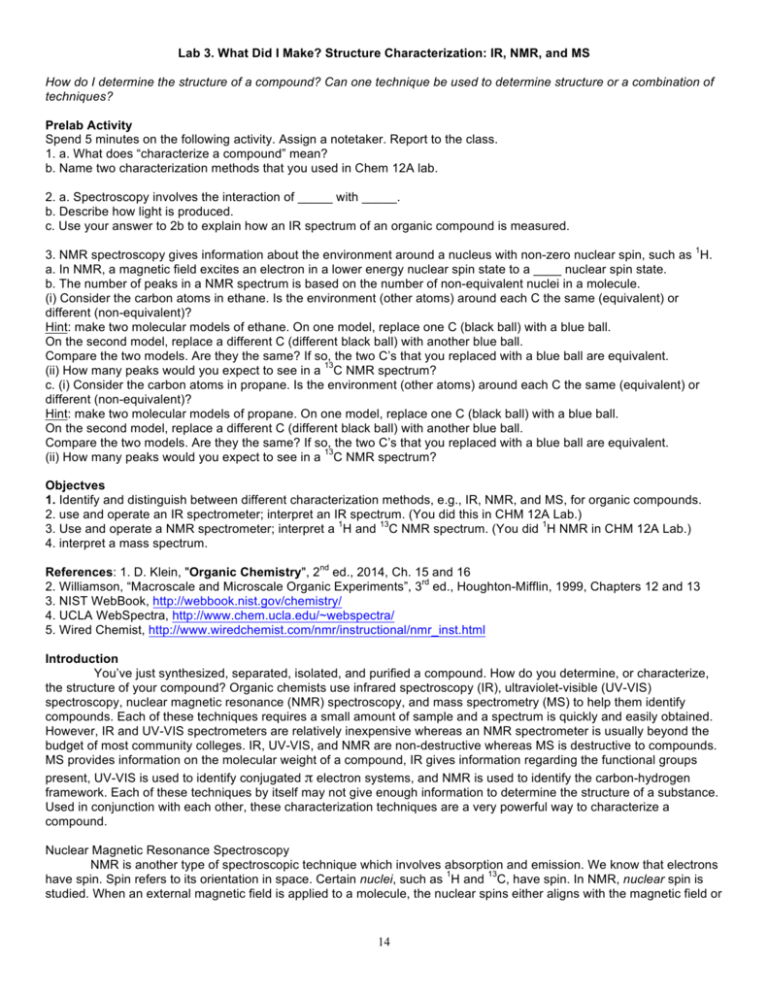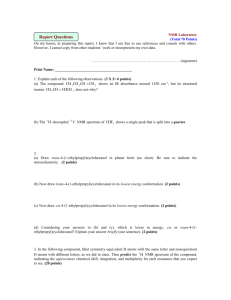Structure Characterization
advertisement

Lab 3. What Did I Make? Structure Characterization: IR, NMR, and MS How do I determine the structure of a compound? Can one technique be used to determine structure or a combination of techniques? Prelab Activity Spend 5 minutes on the following activity. Assign a notetaker. Report to the class. 1. a. What does “characterize a compound” mean? b. Name two characterization methods that you used in Chem 12A lab. 2. a. Spectroscopy involves the interaction of _____ with _____. b. Describe how light is produced. c. Use your answer to 2b to explain how an IR spectrum of an organic compound is measured. 1 3. NMR spectroscopy gives information about the environment around a nucleus with non-zero nuclear spin, such as H. a. In NMR, a magnetic field excites an electron in a lower energy nuclear spin state to a ____ nuclear spin state. b. The number of peaks in a NMR spectrum is based on the number of non-equivalent nuclei in a molecule. (i) Consider the carbon atoms in ethane. Is the environment (other atoms) around each C the same (equivalent) or different (non-equivalent)? Hint: make two molecular models of ethane. On one model, replace one C (black ball) with a blue ball. On the second model, replace a different C (different black ball) with another blue ball. Compare the two models. Are they the same? If so, the two C’s that you replaced with a blue ball are equivalent. 13 (ii) How many peaks would you expect to see in a C NMR spectrum? c. (i) Consider the carbon atoms in propane. Is the environment (other atoms) around each C the same (equivalent) or different (non-equivalent)? Hint: make two molecular models of propane. On one model, replace one C (black ball) with a blue ball. On the second model, replace a different C (different black ball) with another blue ball. Compare the two models. Are they the same? If so, the two C’s that you replaced with a blue ball are equivalent. 13 (ii) How many peaks would you expect to see in a C NMR spectrum? Objectves 1. Identify and distinguish between different characterization methods, e.g., IR, NMR, and MS, for organic compounds. 2. use and operate an IR spectrometer; interpret an IR spectrum. (You did this in CHM 12A Lab.) 1 13 1 3. Use and operate a NMR spectrometer; interpret a H and C NMR spectrum. (You did H NMR in CHM 12A Lab.) 4. interpret a mass spectrum. nd References: 1. D. Klein, "Organic Chemistry", 2 ed., 2014, Ch. 15 and 16 rd 2. Williamson, “Macroscale and Microscale Organic Experiments”, 3 ed., Houghton-Mifflin, 1999, Chapters 12 and 13 3. NIST WebBook, http://webbook.nist.gov/chemistry/ 4. UCLA WebSpectra, http://www.chem.ucla.edu/~webspectra/ 5. Wired Chemist, http://www.wiredchemist.com/nmr/instructional/nmr_inst.html Introduction You’ve just synthesized, separated, isolated, and purified a compound. How do you determine, or characterize, the structure of your compound? Organic chemists use infrared spectroscopy (IR), ultraviolet-visible (UV-VIS) spectroscopy, nuclear magnetic resonance (NMR) spectroscopy, and mass spectrometry (MS) to help them identify compounds. Each of these techniques requires a small amount of sample and a spectrum is quickly and easily obtained. However, IR and UV-VIS spectrometers are relatively inexpensive whereas an NMR spectrometer is usually beyond the budget of most community colleges. IR, UV-VIS, and NMR are non-destructive whereas MS is destructive to compounds. MS provides information on the molecular weight of a compound, IR gives information regarding the functional groups present, UV-VIS is used to identify conjugated π electron systems, and NMR is used to identify the carbon-hydrogen framework. Each of these techniques by itself may not give enough information to determine the structure of a substance. Used in conjunction with each other, these characterization techniques are a very powerful way to characterize a compound. Nuclear Magnetic Resonance Spectroscopy NMR is another type of spectroscopic technique which involves absorption and emission. We know that electrons 1 13 have spin. Spin refers to its orientation in space. Certain nuclei, such as H and C, have spin. In NMR, nuclear spin is studied. When an external magnetic field is applied to a molecule, the nuclear spins either aligns with the magnetic field or 14 against the magnetic field. These nuclear spin states (levels) split into a high energy state and low energy state. When the compound is irradiated with radio waves, these nuclear spins undergo a transition (called a spin flip in NMR) from a lower 1 energy state to a higher energy state. This is the NMR effect. Based on this description, we would think that a H nucleus 13 splits a certain amount and a C splits a different amount. If this were so, then we would not be able to determine the structure of organic compounds using NMR. The NMR effect depends on the environment around each nucleus. The environment is the electrons that surround each nucleus. Since electrons have charge and are in motion, they set up their own local magnetic field around each nucleus (recall electricity and magnetism in your physics class). This local magnetic field works against the applied magnetic field and changes the actual or effective magnetic field felt by each nucleus. For 1 example, if we were looking at H NMR, a H bonded to an O will have a different effective magnetic field than a H bonded to C. We can see these differences in effective magnetic field in NMR and can determine the carbon-hydrogen framework based on an NMR spectrum. In NMR, intensity or absorbance is plotted on the y axis and chemical shift is plotted on the x axis. Chemical shift 1 13 refers to the effective magnetic field strength felt by the nucleus (usually H or C). Since magnetic field strength is very 1 small, the difference in magnetic field strength between the sample and a reference standard (TMS) is plotted. In a H NMR spectrum, look at the following features: 1. number of peaks - gives information on the number of different types of H in compound. 2. size of peaks - gives information on number of each type of H in compound. 3. position of peaks - gives information on the environment around H, i.e., atoms or groups of atoms bonded to H. 4. splitting of the main peak into groups of peaks - gives information on the number of protons bonded to a neighboring carbon. The same features are also seen in NMR spectra for other nuclei. Mass Spectrometry In MS, a sample is bombarded with high energy electrons and dislodges a valence electron from the compound to form a cation radical: + Sample + high energy electron ---> [sample] • + other fragments (1) + where [sample] • is the molecular ion. The ions that are produced go through a magnetic or electric field and are deflected. What determines the amount of deflection? (The amount of deflection depends on the fragment size of the ion.) A mass spectrum is usually represented as a bar graph with the mass to charge (m/z) ratio of the ion plotted on the x axis and the intensity plotted on the y axis. The base peak (tallest peak) is usually the molecular ion peak. The m/z ratio for the base peak is used to determine the molecular weight of the compound. The sample is broken into smaller fragments. These fragments can be used to determine identity of molecule. For Chem 12A, just know that the molecular ion peak tells us the molecular weight of the compound. Materials molecular model kits Bruker FT-IR ChemDoodle NMR spectrum simulator (or Chemagic.com NMR simulator) Various organic solvents picoSpin NMR Procedure Caution: The organic solvents in this experiment are flammable and hazardous. 1. IR and MS. Klein, Ch. 15 Problems. 2. NMR and MS. a. Consider the compounds: hexane, ethanol, acetic acid, ethyl acetate, methyl ethyl ketone, toluene, xylene isomers, Ibuprofen. For each compound, do the following: (i) Draw the structure using ChemDoodle. 1 (ii) Select the structure. Then, go to the Spectrum menu, go to Generate, and choose H NMR to see the spectrum. How many peaks (signals) are shown in the spectrum? Do the number of peaks match the different types of H’s? Look at the integration of each peak. Does the integration match the equivalent H’s? Check the splitting of each signal. Does the splitting match the structure? Based on this information, match each peak to each H in your structure. 13 (iii) Select the structure. Then, go to the Spectrum menu, go to Generate, and choose C NMR to see the spectrum. How many peaks (signals) are shown in the spectrum? Do the number of peaks match the different types of H’s? 15 Match each peak to each C in your structure. (iv) Select the structure. Then, go to the Spectrum menu, go to Generate, and choose Mass Parent Peak to see the spectrum. Does the Mass Parent Peak match the molecular weight of the compound? b. Your group will learn to use the NMR spectrometer. Your instructor will demonstrate the use and operation of this instrument. c. You will work in groups to identify a compound from an NMR spectrum. You will present your results to the class. Sketch spectrum on board, draw your proposed structure and interpret each H NMR spectrum. Look at the: • number of peaks - number of different types of H in compound • size of peaks - number of each type of H in compound • chemical shift (position of peaks) - environment around H, i.e., atoms or groups of atoms bonded to H • splittings into groups of peaks Problems from UCLA WebSpectra, http://www.chem.ucla.edu/~webspectra/ Beginning Compounds 1-4. The chemical formula is given for each compound. Use the degree of unsaturation formula to determine the number of pi bonds or rings or both. One way to determine structure: draw a possible structure based on formula, see if NMR spectrum (number of peaks = number of non-equivalent H’s, peak height, chemical shift, and splitting) fits. Another way to determine structure: number of peaks = number of non-equivalent H’s, match chemical shift to environment, look at splitting patterns to determine number of H’s on adjacent carbon, compare peak height, 3. Klein, Chapter 16, Problems 62-64 combine IR, MS, and NMR to identify a compound. 4. More practice: http://www.chem.ucalgary.ca/courses/351/Carey5th/Carey.html#4 Chapter 13. Waste Disposal: a mind is a terrible thing to waste. Questions 1. IR spectroscopy gives information about bond types. Compare a C-H bond to a C-O bond. Identify the factors that make these two bonds different. How are these differences shown in an IR spectrum? 1 2. NMR spectroscopy gives information about the environment around a nucleus with non-zero nuclear spin, such as H 13 and C. The number of peaks in a NMR spectrum is based on the number of non-equivalent nuclei in a molecule. a. Consider the hydrogen atoms in ethane. (i) Is the environment (other atoms) around each H the same (equivalent) or different (non-equivalent)? How many peaks 1 would you expect to see in a H NMR spectrum? (ii) Is the environment (other atoms) around each C the same (equivalent) or different (non-equivalent)? How many peaks 13 would you expect to see in a C NMR spectrum? b. Consider the hydrogen atoms in propane. (i) Is the environment (other atoms) around each H the same (equivalent) or different (non-equivalent)? How many peaks 1 would you expect to see in a H NMR spectrum? (ii) Is the environment (other atoms) around each C the same (equivalent) or different (non-equivalent)? How many peaks 13 would you expect to see in a C NMR spectrum? 3. In mass spectrometry (MS), an electron collides with a molecule and forms an ion and breaks the molecule into fragments. What type of ion is formed? What information about a molecule does this ion in a MS tell you? 16





